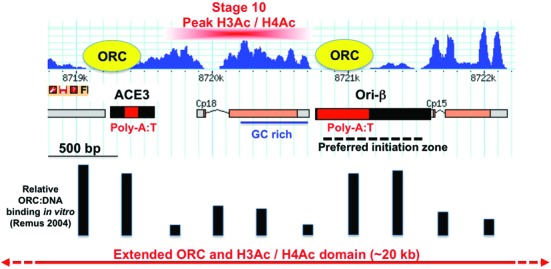Figure 7.

ORC binding to DAFC-66D is influenced by DNA sequence and hyperacetylation of positioned nucleosomes. The DAFC-66D 3.8 kb minimal origin with nucleosome occupancy in vivo (blue) shown above and relative ORC binding to different naked DNA fragments in vitro indicated below (bar graph) (12). The preferred nucleosome and ORC occupancy distributions are inverse of each other. Regions of GC rich DNA (blue line) and conserved, bent, poly A:T DNA (red box) are indicated (94,124). The red box above indicates the region of greatest hyperacetylation on histones H3 and H4 (H3Ac / H4Ac) that occurs exclusively during stages 10–11 when ORC is bound and the origin is active (70). This acetylated nucleosome resides between the sites of high ORC occupancy, with one corresponding to Ori-β, the preferred replication initiation zone (black dotted line) (89,90). This region lies at the center of a diminishing gradient of ORC occupancy and histone acetylation that extends outwards over ∼20 kb epigenome domain (red arrows below) (66,70). These data lead to a model wherein both DNA sequence and nucleosome acetylation contribute to the location and developmental timing of pre-RC assembly at the amplicons.
